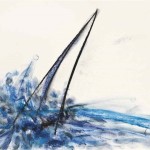Biography
Daniel Flavin was born in Jamaica, New York, in 1933. He studied for the priesthood for a brief period of time before enlisting in the United States Air Force. During military service in 1954–55, Flavin studied art through the University of Maryland Extension Program in Korea. Upon his return to New York in 1956, he briefly attended the Hans Hofmann School of Fine Arts and studied art history at the New School for Social Research. In 1959, he took drawing and painting classes at Columbia University; that year, he began to make assemblages and collages in addition to paintings that pointed to his early interest in Abstract Expressionism. In 1961, he presented his first solo show of collages and watercolors at the Judson Gallery in New York. In the summer of 1961, while working as a guard at the American Museum of Natural History in New York, Flavin started to make sketches for sculptures that incorporated electric lights. Later that year, he translated his sketches into assemblages he called “icons,” which juxtaposed lights onto monochromatic canvases. By 1963, he removed the canvas altogether and began to work with his signature fluorescent tubes; and by 1968, he had developed his sculptures into room-size environments of light. That year, Flavin filled an entire gallery with ultraviolet light at Documenta 4 in Kassel (1968).
In the 1970s and 80s, Flavin began to create more complex figurations of fluorescent tubes, notably his “barred corridors” and corner installations. His work increasingly concentrated on the relationship between his sculptures and the spaces they inhabited. In the 1990s, as institutions began to offer larger galleries to Flavin, the scale of his light installations became more and more grandiose. In 1992, he filled the Solomon R. Guggenheim Museum with multicolored light, taking full advantage of the openness of the Frank Lloyd Wright design. In 1996, he introduced electric green and blue lights into the staircases of the warehouse then occupied by the Dia Art Foundation. Additional sites for his architectural “interventions” include the Hamburger Bahnhof in Berlin, Chianti Foundation in Marfa, Texas, and the church of Santa Maria Annunziata in Chiesa Rossa in Milan, all in 1996.
Major retrospectives of Flavin’s work have been organized by the National Gallery of Canada in Ottawa (1969), St. Louis Art Museum (1973), Kunsthalle Basel (1975), and Museum of Contemporary Art in Los Angeles (1989). He also executed many commissions for public work, including the lighting of several tracks at Grand Central Station in New York in 1976. Flavin died on November 29, 1996, in Riverhead, New York. Both the Deutsche Guggenheim in Berlin in 1999 and the Dia Foundation for the Arts in 2004 mounted major posthumous retrospectives of the artist’s work.

 Untitled (Sails)
Untitled (Sails)